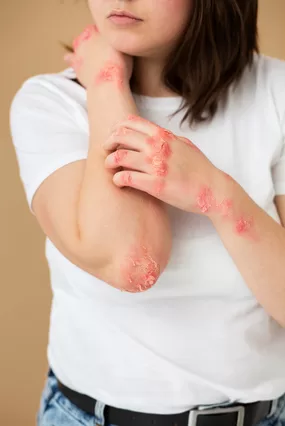What is Psoriasis?
Psoriasis is a common and chronic skin condition driven by the immune system. It is characterized by the appearance of red, scaly plaques on the skin due to the rapid overproduction of skin cells.
There are several types of psoriasis, including chronic plaque psoriasis, guttate psoriasis, flexural psoriasis, palmoplantar psoriasis, and nail psoriasis.
Principles of Treatment
Even with advances in understanding how psoriasis develops, it remains a challenging condition to manage. There is currently no cure, and no single treatment is universally effective. Often, multiple treatments must be tried before finding the most suitable approach, and various treatments may need to be combined or alternated to achieve the best results while minimizing side effects.
The choice of treatment depends on several factors, including:
- The pattern and severity of the disease (e.g., body surface area affected, Psoriasis Area and Severity Index [PASI] score)
- The impact of the disease on the patient (e.g., symptoms, Dermatology Life Quality Index [DLQI] score)
- Patient’s age, overall health, and any comorbid conditions (e.g., psoriatic arthritis, kidney or liver disease)
- Other medications the patient is taking
- Considerations related to pregnancy or plans for conception.
- Patient preferences and the practicality of treatments
General Measures
Avoidance of Triggers
Minimizing factors that can trigger or worsen psoriasis is crucial. These factors may include stress, certain infections like streptococcal infections, and specific medications such as lithium, beta-blockers, and antimalarial drugs.
Associated Conditions
Psoriasis is often linked with other health conditions such as psoriatic arthritis, sleep disturbances, and depression. Managing these associated conditions can also help improve psoriasis. Additionally, since psoriasis is related to metabolic syndrome, lifestyle changes like weight loss, smoking cessation, reducing alcohol intake, and controlling blood pressure may also benefit skin health.
Sun Exposure
Moderate sun exposure can help improve psoriasis, and many individuals notice their symptoms improve during sunny months or after spending time in sunny environments. However, sunburn can worsen it in affected areas, and long-term sun exposure increases the risk of skin aging and skin cancer.
Baths
Soaking in warm water can help soften psoriatic plaques and remove scales. Using soap substitutes or bath oils can be beneficial, while antiseptics should generally be avoided as they may cause irritation. Balneotherapy, which involves bathing in mineral springs, is a popular complementary therapy, though evidence of its effectiveness is limited.
Topical Medications
Emollients
Regular use of emollients and moisturizers helps to soften psoriasis, adding moisture to the skin and improving dryness, scaling, and irritation. A variety of lotions, creams, and ointments are available, with thicker ointments often recommended for chronic plaques and hand or foot psoriasis.
Topical Steroids
Topical steroids are widely used to treat plaque, scalp, flexural psoriasis, and those affecting the palms and soles. They are available in various strengths and formulations and are often combined with other agents like calcipotriol (a vitamin D analog) or salicylic acid. Potent steroids are more effective but come with a higher risk of side effects, including skin thinning and the potential to trigger or worsen certain types of psoriasis. Careful use under medical supervision is necessary, especially during pregnancy.
Tar Preparations
Coal tar is used in various formulations, including solutions, lotions, creams, ointments, gels, and shampoos. It is mainly effective for scalp psoriasis and large thin plaques. However, it can be messy, has a strong odor, and may irritate the skin.
Dithranol
Dithranol is occasionally used for chronic plaque psoriasis. Though effective, it has practical drawbacks, such as staining skin and fabrics, and it requires careful application.
Calcineurin Inhibitors
Tacrolimus ointment and pimecrolimus cream are typically used off-label to treat psoriasis, particularly in sensitive areas like the face, flexures, and genital regions. They are less effective for chronic plaque psoriasis.
Tazarotene
Tazarotene is a topical retinoid used for plaque psoriasis. It can cause skin irritation and is not widely available in some regions.
Roflumilast
Roflumilast 0.3% cream is a topical PDE4 inhibitor approved for treating plaque psoriasis in patients aged 12 years and older.
Keratolytic Agents
Keratolytic agents can help reduce thick scaling. These may contain urea, salicylic acid, or propylene glycol, which work to soften and break down the scales.
Vitamin D Analogs
Compounds like calcipotriol, calcitriol, and tacalcitol are used to reduce the thickness and scaling of plaques. They are applied once or twice daily and are particularly effective for chronic plaque psoriasis and scalp psoriasis. However, they may cause irritation and are not typically recommended for facial psoriasis.
Ultraviolet Treatment
Phototherapy
Phototherapy, which involves the use of UV radiation to treat skin conditions, can be highly effective for psoriasis, especially in cases where topical treatments have not worked or when the affected skin area is too large for topical treatment alone. Typically administered in specialized centers, phototherapy usually requires 2-3 sessions per week for a total of 20-30 treatments.
However, phototherapy is not suitable for everyone. It is generally avoided in individuals with very fair skin, those taking certain immunosuppressive medications, or those with a history of skin cancer. Early side effects can include sunburn and photosensitivity rashes, while long-term risks include skin aging and an increased risk of skin cancer.
Narrowband Ultraviolet B (UVB)
Narrowband UVB, which uses light with wavelengths of 311–312 nm, is particularly effective for thin chronic plaque and guttate psoriasis, especially during the winter months. This treatment is generally safe and well-tolerated. UVB is considered safe during pregnancy, although it degrades folic acid, so supplementation is recommended during treatment.
Psoralen and Ultraviolet A (PUVA)
PUVA therapy combines psoralen (a photosensitizing agent) with long-wave ultraviolet A (UVA) radiation. Psoralens can be administered orally or topically before UVA exposure. PUVA is often used for treating thick plaques or moderate-to-severe psoriasis on the hands and feet. However, photosensitivity can persist for hours after treatment, so patients are advised to avoid sun exposure and wear protective eyewear. PUVA carries a higher risk of skin cancer, particularly squamous cell carcinoma. It is not recommended during pregnancy or breastfeeding.
Systemic Non Biological Therapies
Systemic treatments, which are taken orally or by injection, may be necessary when psoriasis significantly impacts a patient’s physical, social, or psychological health, or when other treatments, including topical therapy and phototherapy, have been ineffective. The choice of systemic medication depends on the individual patient’s needs, as each treatment option has its own set of risks and benefits. Generally, systemic steroids are avoided as they can worsen psoriasis or make it unstable and difficult to control with other therapies.
Methotrexate
Methotrexate is an immunomodulatory and anti-inflammatory drug commonly used to treat psoriasis, psoriatic arthritis, and Crohn’s disease. It is typically taken once a week, either as oral tablets or subcutaneous injections, often with folic acid supplementation to reduce side effects. The dosage is usually adjusted over the initial weeks or months of treatment, and methotrexate can be used long-term if well-tolerated. Approximately 45% of patients achieve a 75% improvement in their PASI score after 12–16 weeks of treatment. Regular blood tests are required to monitor liver function and blood count. Methotrexate can cause fetal harm, so it is important for women to avoid pregnancy while taking the drug and for at least three months after stopping it.
Ciclosporin
Ciclosporin is an immunosuppressant used for short-term treatment of severe plaque psoriasis or pustular psoriasis. It is typically prescribed for 8–12 weeks, with the dosage tailored to the patient’s weight and response to treatment. Ciclosporin has a rapid onset of action, making it particularly useful in acute cases. However, due to its side effects, including hypertension, renal failure, and increased risk of infections and skin cancer, regular monitoring is necessary. Ciclosporin should be discontinued or minimized during pregnancy due to potential risks, including hypertension.
Acitretin
Acitretin, a retinoid similar to vitamin A, is particularly effective for palmoplantar psoriasis. The dosage varies and is often combined with phototherapy. While acitretin can be effective, it has significant side effects, including the risk of serious birth defects. Women of childbearing age are generally not prescribed acitretin, and pregnancy must be strictly avoided for at least three years after stopping the medication.
Fumaric Acid Esters
Fumaric acid esters are immunosuppressants that have shown effectiveness in treating psoriasis, although they are not available in all regions. The dosage is gradually increased to achieve therapeutic effects, with regular blood tests required to monitor kidney, liver, and blood cell health. Side effects include gastrointestinal discomfort and a rare but serious risk of progressive multifocal leukoencephalopathy, a viral infection of the nervous system.
Biological Therapies
Biological therapies, commonly referred to as biologics, are treatments that use monoclonal antibodies or recombinant proteins designed to target specific components of the immune system. These therapies are often highly effective for managing psoriasis, especially in cases where other treatments have failed or are contraindicated.
Biologics are generally reserved for patients with moderate-to-severe disease who have not responded to topical or systemic treatments.
Types
Currently, several classes of biologics are available or under development, each targeting different immune pathways:
- Tumor Necrosis Factor-alpha (TNFα) Inhibitors: These include infliximab, etanercept, adalimumab, certolizumab, and golimumab. TNFα inhibitors work by blocking a specific protein involved in inflammatory responses, making them effective for treating psoriasis.
- Interleukin 17 (IL-17) Inhibitors: This group includes secukinumab, ixekizumab, and brodalumab. IL-17 inhibitors target a cytokine involved in inflammation and are particularly effective for plaque psoriasis.
- Interleukin 12 and 23 (IL-12 and IL-23) Inhibitors: This class includes ustekinumab, tildrakizumab, guselkumab, and risankizumab.
Administration and Biosimilars
Most biologics are given via subcutaneous injection, except for infliximab, which is given intravenously. Infliximab is a chimeric antibody (composed of mouse and human protein), which can sometimes cause infusion reactions and the formation of antibodies against the drug.
Biosimilars are nearly identical versions of original biologic drugs that have lost patent protection. These alternatives are generally available at a lower cost and have been developed for drugs like infliximab and etanercept.
Emerging Treatments
New oral drugs are under development, including small molecule compounds that target specific signaling pathways, such as JAK inhibitors and PDE inhibitors. Due to their low molecular weight, there is potential for these treatments to be formulated for topical application, expanding their use in psoriasis management.
Conclusion
In conclusion, the advancements in psoriasis treatments offer renewed hope for individuals seeking effective solutions to manage their condition. With a range of breakthrough therapies available, from topical treatments to cutting-edge biological therapies, there is a promising path toward clearer, healthier skin. While psoriasis remains a challenging condition, the power of these innovative treatments can significantly improve the quality of life for those affected, offering not just relief but a transformative impact on both physical and emotional well-being.





